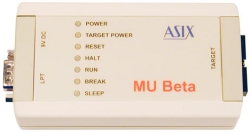|
The unique and affordable PIC emulator
MU Beta is a Real-Time In-Circuit Emulator for the most popular 6-pin to 18-pin Microchip PIC® microcontrollers. It offers many professional level features for a very low price. It is designed to multiply your productivity and comfort in the development of PIC applications. It is extremely beneficial as an educational tool.
Now you can connect MU Beta to USB via the
EMUSB interface.
Advantages for any PIC MCU user
Very low price of this emulator with no hidden costs allows the user for a quite different approach to emulator's usage - hardly impossible in the past.
Small system design - when designing systems based on small PIC MCUs like power supplies, sensors, alarms, simple communication units, robots, controllers, toys, etc., the MU Beta will cut the time required for firmware development to only a fraction. You can focus on new features of your product rather than spending hours by looking for forgotten data bank select bit...
Complex systems with distributed intelligence - when using more processors, why not to use more emulators? The price of MU Beta allows for such solution. Then, the debugging of tasks like inter-processor communication will no longer be a nightmare.
Educational - excellent tool for the most efficient teaching of embedded microcontroller technology. Enables your students to fast and deeply understand the processes inside the microcontrollers - why to waste time by describing a behavior of a "black box" when you can demonstrate everything absolutely clearly.
Many advanced technical features
-
Extremely flexibile
-
MU Beta is based on the state-of-the-art programmable gate arrays (FPGA). This solution is far more flexible and offers more functionality than the "traditional" one, based on bond-out chips specially manufactured. The analogue peripherals are designed to be compatible with the ones found on the original PIC MCUs.
The target device type, clock frequency, oscillator type, reset, watchdog and many other parameters are software selectable, with no confusing jumper settings or interchangeable oscillator modules. The user only needs to connect one of the small target probes for 6-pin to 18-pin devices.
An internal clock frequency synthesizer provides the clock in the range from 25 kHz to 20 MHz (full speed of emulated devices). The user can select among various oscillator modes: crystal, RC with CLKOUT equal to Fosc/4, external clock up to 10 MHz, or external RC oscillator.
Target application independent functionality: the emulator can be used with or without a target system (which allows to test internal routines independently of application), like a "real-time software simulator".
-
Really non-intrusive
-
All device resources are available for the user's application. Nothing is used by the emulator hardware or software. MU Beta offers excellent device resource accessibility even when running at full application speed, so you do not have to stop the real-time run to watch and modify the device registers.
-
Low voltage support
-
Low voltage applications? No problem with MU Beta. Target application supply voltage can be as low as 2 V and your emulator will still work fine. No obvious 5 V only limitations.
-
Extensive break logic options
-
Extensive break logic possibilities: Unlimited number of breakpoints anywhere in the code memory, activated BEFORE instruction execution. Many other break conditions: file register breaks in data memory, Timer0 overflow, Trace buffer overflow, Watchdog timer overflow, Stack overflow/underflow, Break on external input (Trigger In).
-
Any many other beneficial features...
-
32-bit instruction cycle counter - stopwatch - with overflow detection
accurately counts active cycles both in Run or Step modes. The time is displayed
in cycles and in microseconds. A second - differential - counter is implemented in software.
Flexibility of emulator circuitry allows software upgrades (e.g. via Internet) of the emulator hardware and even custom modifications to accomodate any user need.
Trace memory 256 instructions deep, tracing is fully user selectable for arbitrary (even discontinuous) locations and areas.
Default device socket is DIP, SMD headers can be ordered as an option.
|
|

Larger image
More images:
MU Beta with EMUSB
Inside the box
Beta with 18-pin probe
18-pin emulation probe
8-pin emulation probe
DIP->SOIC18 adaptor
DIP->SOIC8 adaptor
Supported devices
6-pin:
8-pin:
- PIC12C508A/509A
- PIC12F629
- PIC12F675
14-pin:
- PIC16F630
- PIC16F676
(limited to 4 A/D channels - AN0..3)
18-pin:
- PIC16C54C/56A/58B
- PIC16C710/PIC16C711
- PIC16C715
- PIC16F84/84A
- PIC16C554/558
- PIC16C620A/621A/622A
- PIC16F627/628
Features
- Non-compromised background debugging, all device resources are user available
- Target application power supply from 2.5 to 5.5V
- Software selectable oscillator frequency and other flexible clock frequency options
- Target application independent functionality (hardware simulator mode)
- Extensive break logic options
- Flexible reset options
- True HALT state
- Trigger In and Trigger Out signals
- 32-bit instruction stopwatch
- Flexible watchdog setting
- Off-line mode
- Well-arranged LED mode indication
- Reconfigurable hardware
- Trace memory, conditional trace
- Compact mechanical construction
- Fast PC interface via parallel port or via USB (using
EMUSB).
Contents
- Emulator base unit
- Power supply (continental Europe countries only)
- PC connection cable
- Target probes and cables
- Target I/O protector
- CD-ROM with software and electronic manual
Options
|
|
